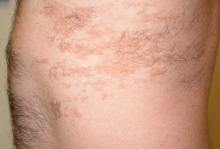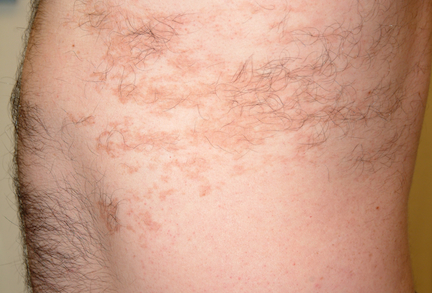User login
After 28 years, a diagnosis is sought
HISTORY
This 40-year-old man was urged by his wife to consult dermatology about a lesion he first noted on his left flank when he was 12. Since then, it has grown darker and more hairy but otherwise has not changed. It has never been symptomatic, and he has no other lesions. The patient claims to be in good health.
The lesion, which covers a good portion of the patient’s left lateral chest wall, is uniformly light brown. The surface is slightly rough and decidedly hypertrichotic, with markedly irregular margins. No other significant lesions are seen elsewhere on the patient’s skin.
DISCUSSION
The shoulder and pectoral areas are far more common locations than the chest wall for Becker’s nevus. S. William Becker first described this curious condition in 1948, in two young men who had acquired melanosis and hypertrichosis in unilateral distribution. Originally called Becker’s melanosis, it has long been known by its present name and has now been extensively investigated.
Though the exact pathogenesis of Becker’s nevus remains uncertain, much has been learned. For example, it appears that androgens play a role in its acquisition. Supporting evidence includes the history of peripubertal development, male preponderance, presence of hypertrichosis, and even the occasional development of acneiform eruptions within the patch. Special studies have also reported a significant increase in the number of androgen receptors in these patches.
The typical natural history of this lesion is as follows: First, smaller, widely scattered tan-to-orange macules appear, increase in number, and then coalesce to form a larger patch. Over the next few months to years, darker hairs begin to appear within the lesion, as well as on its periphery (though a small percentage of BN lesions never develop hair), while the skin in the middle of the lesion may become slightly thicker. The configuration of the lesion’s borders is said to be geographic (ie, indented and irregular).
Histologically, Becker’s is distinguished by mild acanthosis and hyperkeratosis, with regular elongation of rete ridges. There is also hyperpigmentation of the epidermis, an increase in smooth muscle, and increased numbers of hair follicles.
The main item in the differential is McCune-Albright syndrome, a rare genetic disorder involving defects of bones, skin pigmentation, and hormonal abnormalities such as premature puberty. Highly variable in its presentation, it often presents with unilateral café-au-lait macules at birth, but these have no hypertrichosis.
Far more men than women develop Becker’s nevus. Rarely, unilateral breast hypoplasia has been reported.
TREATMENT
Primarily sought for cosmetic reasons, treatment entails the use of lasers, with variable results. Elimination of hairs is relatively easy to achieve, but resolution of the hyperpigmentation is less predictable.
This particular patient was satisfied just to know the correct diagnosis and benign prognosis, though he was instructed to watch the lesion for signs of significant change.
TAKE-HOME LEARNING POINTS
• Becker’s nevus (BN) is usually found on the shoulder, but can develop anywhere on the trunk and is occasionally seen on the extremities.
• The chances of malignant transformation within a BN are extremely low.
• There is abundant evidence of the influence of androgens on the development of BNs, including hypertrichosis, prevalence in males, and peripubertal onset.
• Ipsilateral hypoplasia of the breast has been reported in conjunction with BN.
• Multiple-laser treatment of BN can lighten the hyperpigmentation but may result in unacceptable loss of normal pigment in treated areas.
HISTORY
This 40-year-old man was urged by his wife to consult dermatology about a lesion he first noted on his left flank when he was 12. Since then, it has grown darker and more hairy but otherwise has not changed. It has never been symptomatic, and he has no other lesions. The patient claims to be in good health.
The lesion, which covers a good portion of the patient’s left lateral chest wall, is uniformly light brown. The surface is slightly rough and decidedly hypertrichotic, with markedly irregular margins. No other significant lesions are seen elsewhere on the patient’s skin.
DISCUSSION
The shoulder and pectoral areas are far more common locations than the chest wall for Becker’s nevus. S. William Becker first described this curious condition in 1948, in two young men who had acquired melanosis and hypertrichosis in unilateral distribution. Originally called Becker’s melanosis, it has long been known by its present name and has now been extensively investigated.
Though the exact pathogenesis of Becker’s nevus remains uncertain, much has been learned. For example, it appears that androgens play a role in its acquisition. Supporting evidence includes the history of peripubertal development, male preponderance, presence of hypertrichosis, and even the occasional development of acneiform eruptions within the patch. Special studies have also reported a significant increase in the number of androgen receptors in these patches.
The typical natural history of this lesion is as follows: First, smaller, widely scattered tan-to-orange macules appear, increase in number, and then coalesce to form a larger patch. Over the next few months to years, darker hairs begin to appear within the lesion, as well as on its periphery (though a small percentage of BN lesions never develop hair), while the skin in the middle of the lesion may become slightly thicker. The configuration of the lesion’s borders is said to be geographic (ie, indented and irregular).
Histologically, Becker’s is distinguished by mild acanthosis and hyperkeratosis, with regular elongation of rete ridges. There is also hyperpigmentation of the epidermis, an increase in smooth muscle, and increased numbers of hair follicles.
The main item in the differential is McCune-Albright syndrome, a rare genetic disorder involving defects of bones, skin pigmentation, and hormonal abnormalities such as premature puberty. Highly variable in its presentation, it often presents with unilateral café-au-lait macules at birth, but these have no hypertrichosis.
Far more men than women develop Becker’s nevus. Rarely, unilateral breast hypoplasia has been reported.
TREATMENT
Primarily sought for cosmetic reasons, treatment entails the use of lasers, with variable results. Elimination of hairs is relatively easy to achieve, but resolution of the hyperpigmentation is less predictable.
This particular patient was satisfied just to know the correct diagnosis and benign prognosis, though he was instructed to watch the lesion for signs of significant change.
TAKE-HOME LEARNING POINTS
• Becker’s nevus (BN) is usually found on the shoulder, but can develop anywhere on the trunk and is occasionally seen on the extremities.
• The chances of malignant transformation within a BN are extremely low.
• There is abundant evidence of the influence of androgens on the development of BNs, including hypertrichosis, prevalence in males, and peripubertal onset.
• Ipsilateral hypoplasia of the breast has been reported in conjunction with BN.
• Multiple-laser treatment of BN can lighten the hyperpigmentation but may result in unacceptable loss of normal pigment in treated areas.
HISTORY
This 40-year-old man was urged by his wife to consult dermatology about a lesion he first noted on his left flank when he was 12. Since then, it has grown darker and more hairy but otherwise has not changed. It has never been symptomatic, and he has no other lesions. The patient claims to be in good health.
The lesion, which covers a good portion of the patient’s left lateral chest wall, is uniformly light brown. The surface is slightly rough and decidedly hypertrichotic, with markedly irregular margins. No other significant lesions are seen elsewhere on the patient’s skin.
DISCUSSION
The shoulder and pectoral areas are far more common locations than the chest wall for Becker’s nevus. S. William Becker first described this curious condition in 1948, in two young men who had acquired melanosis and hypertrichosis in unilateral distribution. Originally called Becker’s melanosis, it has long been known by its present name and has now been extensively investigated.
Though the exact pathogenesis of Becker’s nevus remains uncertain, much has been learned. For example, it appears that androgens play a role in its acquisition. Supporting evidence includes the history of peripubertal development, male preponderance, presence of hypertrichosis, and even the occasional development of acneiform eruptions within the patch. Special studies have also reported a significant increase in the number of androgen receptors in these patches.
The typical natural history of this lesion is as follows: First, smaller, widely scattered tan-to-orange macules appear, increase in number, and then coalesce to form a larger patch. Over the next few months to years, darker hairs begin to appear within the lesion, as well as on its periphery (though a small percentage of BN lesions never develop hair), while the skin in the middle of the lesion may become slightly thicker. The configuration of the lesion’s borders is said to be geographic (ie, indented and irregular).
Histologically, Becker’s is distinguished by mild acanthosis and hyperkeratosis, with regular elongation of rete ridges. There is also hyperpigmentation of the epidermis, an increase in smooth muscle, and increased numbers of hair follicles.
The main item in the differential is McCune-Albright syndrome, a rare genetic disorder involving defects of bones, skin pigmentation, and hormonal abnormalities such as premature puberty. Highly variable in its presentation, it often presents with unilateral café-au-lait macules at birth, but these have no hypertrichosis.
Far more men than women develop Becker’s nevus. Rarely, unilateral breast hypoplasia has been reported.
TREATMENT
Primarily sought for cosmetic reasons, treatment entails the use of lasers, with variable results. Elimination of hairs is relatively easy to achieve, but resolution of the hyperpigmentation is less predictable.
This particular patient was satisfied just to know the correct diagnosis and benign prognosis, though he was instructed to watch the lesion for signs of significant change.
TAKE-HOME LEARNING POINTS
• Becker’s nevus (BN) is usually found on the shoulder, but can develop anywhere on the trunk and is occasionally seen on the extremities.
• The chances of malignant transformation within a BN are extremely low.
• There is abundant evidence of the influence of androgens on the development of BNs, including hypertrichosis, prevalence in males, and peripubertal onset.
• Ipsilateral hypoplasia of the breast has been reported in conjunction with BN.
• Multiple-laser treatment of BN can lighten the hyperpigmentation but may result in unacceptable loss of normal pigment in treated areas.

